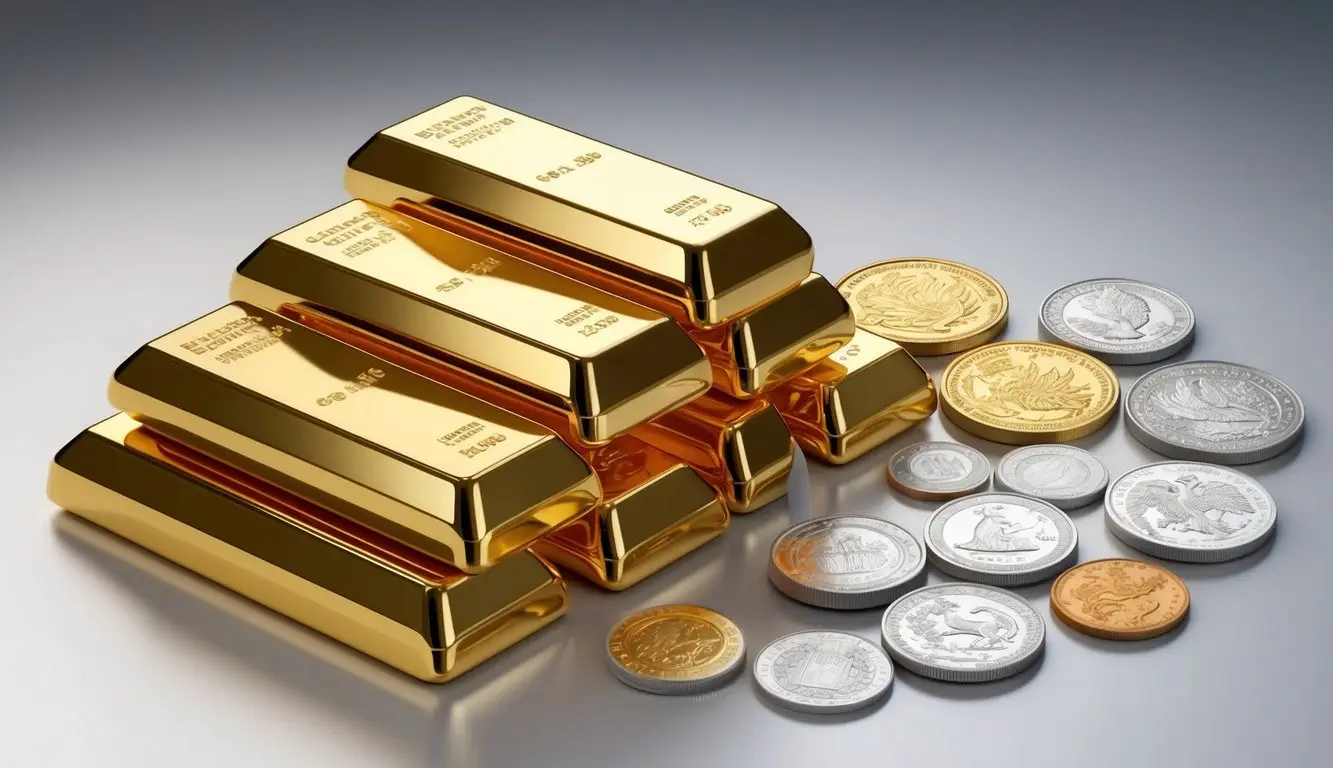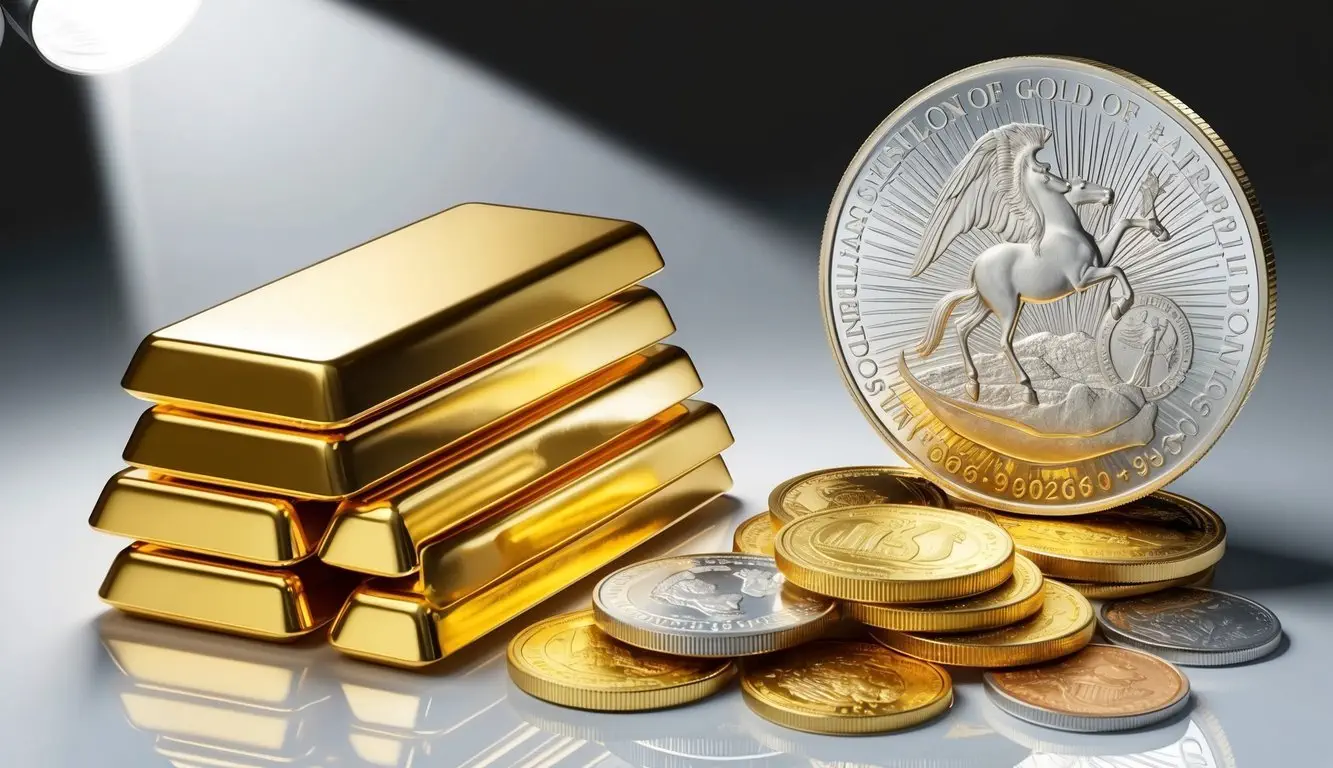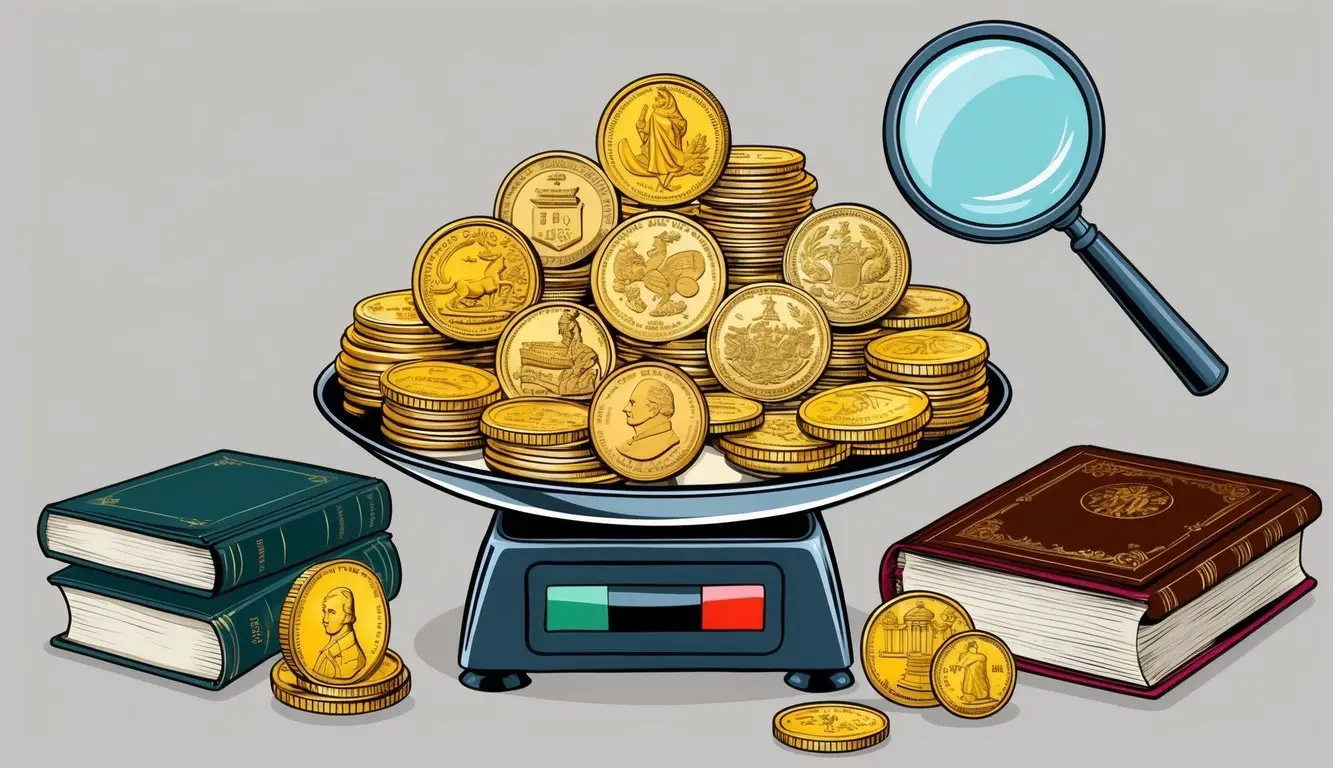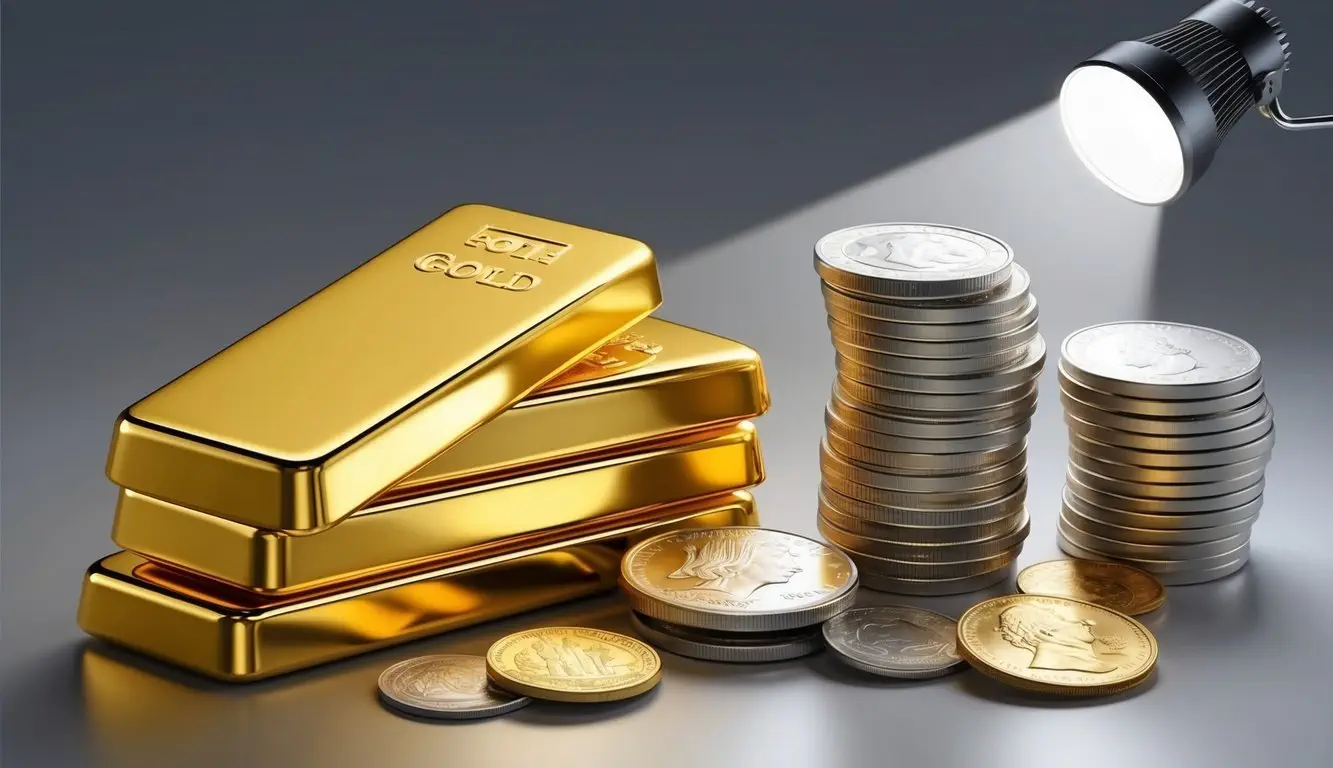When it comes to investing in precious metals, gold remains a popular choice. Many investors face a key decision: should they buy gold bullion or numismatic coins?

Gold bullion offers investors direct exposure to the metal’s market price, while numismatic coins may provide both precious metal value and potential collector’s premium. Bullion coins like American Gold Eagles or Canadian Maple Leafs are valued primarily for their gold content, typically selling for a small percentage over the spot price.
Numismatic coins, on the other hand, carry additional value based on rarity, condition, and historical significance. These collector coins often trade at prices significantly higher than their metal content alone. Investors should consider their goals, risk tolerance, and interest in coin collecting when deciding between these two forms of precious metals investment.
Gold Bullion vs Numismatic Coins

The gold investment market offers two distinct categories of products that serve different purposes for investors and collectors. These categories differ primarily in how their value is determined and why people purchase them.
What Is Gold Bullion
Gold bullion refers to gold products valued primarily for their precious metal content rather than collectible qualities. These include gold bars, rounds, and bullion coins produced by government mints worldwide.
The price of gold bullion closely tracks the spot price of gold in the market. For example, a 1-ounce American Gold Eagle typically sells for the current gold spot price plus a small premium (usually 3-8%).
Bullion products contain a specific, guaranteed weight and purity of gold. Common purities include 22-karat (91.67% pure) and 24-karat (99.99% pure) gold.
Popular gold bullion coins include:
- American Gold Eagle
- Canadian Gold Maple Leaf
- South African Krugerrand
- Austrian Gold Philharmonic
Investors choose bullion primarily as a hedge against inflation and economic uncertainty, not for aesthetic or historical value.
What Are Numismatic Coins
Numismatic coins are collectible coins whose value exceeds their metal content due to rarity, condition, historical significance, and collector demand. These coins typically command substantial premiums over their gold content value.
Unlike bullion, numismatic coins are often graded by professional services on a 70-point scale. Higher grades indicate better preservation and higher values. A coin’s mintage (how many were produced) significantly impacts its rarity and price.
Historical gold coins like pre-1933 American gold coins, ancient Greek and Roman coins, and limited-edition commemorative issues fall into this category. Their prices can fluctuate based on collector interest and market trends.
Numismatic coins often feature beautiful designs, historical connections, and cultural significance. Their value can appreciate independently of gold market movements due to their collectible nature.
Collectors value these coins for their artistry, historical importance, and the excitement of owning something truly rare.
Factors Influencing Value

The value of both gold bullion and numismatic coins depends on several key elements that collectors and investors must understand. These factors range from market conditions and metal content to the historical significance and rarity of particular pieces.
Market Value Considerations
Spot price forms the foundation for gold bullion valuation. This price reflects the current trading value of gold per ounce in international markets. Bullion typically sells for spot price plus a small premium.
Numismatic coins, however, often trade significantly above their metal content value. These premiums vary based on dealer markup, market demand, and acquisition difficulty.
Face value has minimal impact on precious metal coins. A one-ounce Gold Eagle has a $50 face value but trades based on its gold content plus premiums.
Market liquidity also affects value. Bullion generally offers better liquidity than rare coins, with narrower buy-sell spreads. During economic uncertainty, premium differences can shift dramatically.
The Role of Rarity and Condition
Condition impacts numismatic coins far more than bullion. Professional grading services use a 70-point scale to rate coin preservation, with mint state (MS) designations commanding the highest prices.
For bullion, condition matters less as long as weight remains consistent. However, severely damaged bullion may trade at discounts to spot price.
Rarity through limited mintage creates substantial value for numismatic coins. Consider these examples:
| Coin | Mintage | Value Premium |
|---|---|---|
| 1909-S VDB Lincoln Cent | 484,000 | Very High |
| 1893-S Morgan Dollar | 100,000 | Very High |
| Common Gold Eagle | Millions | Low (near spot) |
Population reports from grading services help investors track surviving specimens, especially those in top condition.
Historical Significance and Collectibility
Coins connected to significant historical events often command substantial premiums. The 1857 SS Central America shipwreck gold coins exemplify this phenomenon, selling for multiples of their gold value.
Market enthusiasm for particular designs or series drives collectibility. The Saint-Gaudens Double Eagle remains among the most sought-after gold coins for its artistic merit.
Age alone doesn’t guarantee value. Some ancient coins with high survival rates trade for modest premiums over metal content.
Collector tastes evolve over time, affecting market values. Series that were once overlooked can suddenly gain popularity, driving prices upward.
Authentication becomes increasingly important as collectibility rises. Counterfeit detection tools have become essential for serious numismatic investors.
Investment Perspectives

Gold and silver investments come in various forms, each with distinct advantages depending on investor goals. The choice between bullion and numismatic coins involves considerations of market liquidity, long-term value preservation, and potential growth.
Bullion Coins as an Investment
Bullion coins offer a straightforward way to invest in precious metals. These coins are valued primarily for their gold or silver content rather than rarity or collectibility.
Key advantages of bullion investments:
- Prices closely track the spot price of gold and silver
- Lower premiums over spot price compared to numismatic coins
- High liquidity in the marketplace
- Easy to buy, sell, and verify authenticity
Bullion rounds and government-minted coins like American Eagles or Canadian Maple Leafs provide a reliable store of value. Their worth remains relatively stable during economic uncertainty.
Many investors choose bullion as a hedge against inflation and currency devaluation. The value of gold and silver typically moves independently from stock markets, making them useful for portfolio diversification.
Investing in Numismatic Coins
Numismatic coins offer potential returns beyond just metal content. These collectible coins derive value from rarity, historical significance, condition, and collector demand.
Factors affecting numismatic value:
- Mintage numbers (fewer coins = higher potential value)
- Condition/grade
- Historical significance
- Age and design popularity
- Market demand among collectors
Numismatic investments require specialized knowledge. Understanding grading standards, authentication processes, and market trends is essential for success in this space.
Unlike bullion, numismatic coins may appreciate significantly during periods when gold prices remain flat. However, they typically carry higher dealer premiums and may experience less liquidity during market downturns.
Diversifying with Gold and Silver
A balanced precious metals portfolio often includes both gold and silver investments. Each metal offers distinct advantages and performs differently across market cycles.
Comparison of gold vs. silver investments:
| Feature | Gold | Silver |
|---|---|---|
| Price volatility | Lower | Higher |
| Industrial demand | Limited | Substantial |
| Storage requirements | Compact | More space needed |
| Entry cost | Higher | More accessible |
Silver often experiences more dramatic price swings than gold. This volatility creates opportunities for active investors but introduces additional risk.
Many financial advisors recommend allocating 5-15% of an investment portfolio to precious metals. This allocation helps protect against inflation while providing growth potential through market cycles.
Buying and Selling Considerations

When entering the precious metals market, understanding how to buy and sell effectively can significantly impact your investment returns. The transaction process differs notably between bullion and numismatic coins, with unique pricing structures and marketplace dynamics.
Understanding Premiums and Spot Price
Spot price represents the current market value of the raw precious metal. This price serves as the foundation for all gold and silver transactions. Bullion typically carries a smaller premium (3-8% above spot) because its value is primarily in its metal content.
Numismatic coins command much higher premiums, sometimes 20-100% above their metal value. These premiums reflect rarity, historical significance, and collector demand rather than just metal content.
Premiums fluctuate based on:
- Market volatility
- Supply constraints
- Dealer inventory levels
- Coin popularity
During market uncertainty, premiums often increase as demand rises. Tracking the premium-to-spot ratio helps investors identify good buying opportunities and avoid overpaying.
Where to Purchase Bullion and Numismatic Coins
Reputable Dealers: Established precious metals dealers offer authenticated products with reasonable premiums. They typically maintain diverse inventory and provide buyback programs for future liquidity.
Local Coin Shops: These businesses allow physical inspection before purchase and often build long-term relationships with collectors. Some specialize in numismatic coins and offer expert grading advice.
Online Marketplaces: Major retailers like APMEX, JM Bullion, and SD Bullion provide extensive selection and competitive pricing. They generally have lower overhead costs than brick-and-mortar stores.
Auctions: Rare numismatic coins frequently appear at specialized auctions. These venues attract serious collectors but require research and experience to navigate effectively.
Always verify dealer reputation through industry associations and customer reviews before making significant purchases.
Assessing the Physical Condition
For bullion, condition matters primarily for resale value. Minor handling marks typically don’t affect value significantly, but severe damage can reduce worth to melt value only.
With numismatic coins, condition is paramount. Professional grading services like PCGS and NGC use a 70-point scale to evaluate coins. Each grade increment can dramatically change a coin’s value.
Key condition factors include:
- Surface preservation (scratches, nicks)
- Luster (original mint shine)
- Strike quality (detail sharpness)
- Toning (natural color changes)
Slabbed (professionally graded and sealed) numismatic coins generally command higher prices and sell more easily than ungraded specimens. For valuable numismatics, the cost of professional grading is usually worthwhile, as it authenticates the coin and establishes its condition objectively.
Practicalities of Coin Ownership

Owning gold and collectible coins requires thoughtful management beyond the initial purchase. Proper storage, insurance coverage, and authentication are essential components of responsible coin ownership.
Storage and Security
Secure storage is crucial for protecting valuable coins. Many collectors use home safes for convenient access while maintaining security. These safes should be fireproof and bolted to the floor or wall.
For higher-value collections, safety deposit boxes at banks offer superior protection. The annual rental fee is typically worth the peace of mind they provide.
Some specialized companies like Provident Metals offer allocated storage services where your coins remain your legal property while being stored in high-security vaults.
Never store valuable coins in ordinary containers or display cases that lack proper security features. Moisture-controlled environments are essential, as humidity can damage both gold bullion and collectible coins over time.
Consider using acid-free coin holders or capsules to prevent chemical damage, especially for numismatic pieces where condition directly affects value.
Insurance and Safety Precautions
Standard homeowners insurance typically provides limited coverage for coin collections. For collections exceeding a few thousand dollars, specialized collectibles insurance is recommended.
When obtaining insurance:
- Document your collection with photographs
- Keep receipts and certificates of authenticity
- Get professional appraisals for high-value pieces
- Update your coverage as your collection grows
Physical gold and collectible coins should be transported carefully and discreetly. Avoid establishing patterns when visiting your safety deposit box or making large purchases.
Online security is equally important. Be cautious about sharing information about your collection on social media or forums where this information could be misused.
Consider setting up a home security system with cameras if you store valuable coins at home.
Authentication and Appraisal
Authentication is essential when acquiring coins, especially numismatic pieces where counterfeits are common. Reputable dealers often sell coins in tamper-evident packaging with certification numbers.
Professional grading services like NGC and PCGS provide:
- Third-party verification of authenticity
- Condition assessment on a standardized scale
- Protective slabbing to prevent damage
- Documentation that enhances resale value
For collectible coins and even standard legal tender gold coins, the grade can significantly impact value. A single grade difference can mean thousands of dollars for rare specimens.
Periodic reappraisal is advisable as market values fluctuate. Established coin collectors recommend getting updated appraisals every 3-5 years or when market conditions change significantly.
When selling, authentication documentation helps you receive fair market value and provides buyers with confidence in their purchase.
Design and Minting Process

The creation of gold and silver coins involves detailed craftsmanship and precise manufacturing techniques. Both bullion and numismatic coins follow specific production protocols, but with distinct differences in their design complexity and intended purpose.
Unique Designs of Numismatic Coins
Numismatic coins feature intricate, artistic designs that make them attractive to collectors. These designs often commemorate historical events, famous people, or cultural symbols. Private mints and government facilities employ skilled artists and engravers to create master dies with extraordinary detail.
The design process for collectible coins may take months or even years. Artists submit concepts, create sketches, and develop 3D models before final approval. This meticulous attention to detail contributes to the higher premium collectors pay for these pieces.
Many famous numismatic series like the American Gold Eagle and Canadian Maple Leafs include special edition designs with unique finishing techniques, such as frosted elements or selective coloring. These artistic qualities often become more valuable over time, especially for limited mintages.
Production of Bullion Coins
Bullion coins prioritize precious metal content over artistic complexity. Their production focuses on consistency and efficiency. Mints use high-speed presses that can produce thousands of coins per hour.
The manufacturing process begins with precious metal refinement to ensure purity. Gold and silver are melted, formed into blanks, and then struck with dies under tremendous pressure. Quality control measures verify weight, dimensions, and finish.
Most bullion coins feature simpler, standardized designs that remain consistent year after year. The Canadian Maple Leaf, for example, has maintained its iconic maple leaf design since 1979, with only minor modifications.
Production quantities for bullion coins significantly exceed numismatic issues, making them more accessible to investors seeking gold and silver at prices closer to spot market values.
Recognition of Legal Tender
Both bullion and numismatic coins often carry legal tender status, though their face values are typically much lower than their metal content worth. This official designation provides authentication and legitimacy.
Government mints like the U.S. Mint, Royal Canadian Mint, and Perth Mint produce coins with guaranteed weight and purity backed by national governments. Each coin bears official markings including denomination, year of issue, and metal content.
Legal tender status offers distinct advantages, including easier verification and, in some countries, tax benefits. For example, certain gold coins may be exempt from sales tax or can be included in retirement accounts.
The face value printed on these coins serves primarily as a symbolic representation rather than reflecting actual market value. A one-ounce gold Canadian Maple Leaf might carry a $50 face value while containing gold worth over $1,800.
Market Dynamics and Trends

Investors must understand how different factors affect the value of their precious metal investments. Both bullion and numismatic markets respond to distinct forces that drive prices and investment potential.
Fluctuations in Bullion and Numismatic Markets
Gold bullion prices typically follow the spot price of gold closely. When gold prices rise or fall, bullion values adjust almost immediately. In 2024, gold prices reached new highs, breaking $2,400 per ounce before adjusting.
Silver bullion shows similar patterns but with greater volatility. It often experiences larger percentage swings than gold, making it both riskier and potentially more rewarding for investors.
Numismatic coins follow different patterns. While gold content provides a value floor, collector premiums can fluctuate independently from metal prices. Rare coins have shown price stability during bullion downturns.
Market liquidity differs significantly too. Gold bars and bullion coins trade with narrow buy-sell spreads, while rare numismatics may take longer to sell at optimal prices.
The Impact of Economic Indicators
Inflation concerns drive bullion demand. When inflation rises, investors often turn to gold as a hedge, pushing prices higher.
Interest rates show an inverse relationship with gold prices. Higher rates increase opportunity costs for holding non-yielding assets like gold bars, potentially decreasing their market value.
Political uncertainty creates bullion price spikes. Elections, geopolitical conflicts, and policy changes prompt investors to seek safety in physical gold.
Numismatic markets respond more to collector sentiment than economic indicators. During economic downturns, premium coins sometimes gain value as wealthy collectors continue acquisitions.
Currency strength, particularly the US dollar, affects gold pricing. A weaker dollar typically corresponds with stronger gold prices, as international buyers find American gold more affordable.
Legal and Regulatory Considerations

Investing in gold requires understanding specific legal frameworks that govern both bullion and numismatic coins. These regulations affect taxation, reporting requirements, and consumer protections when buying precious metals.
Tax Implications
Gold investments face different tax treatments depending on their classification. Bullion coins are typically taxed as collectibles with a maximum federal tax rate of 28% on long-term capital gains, higher than the 15-20% rate for most investments.
Numismatic coins follow the same collectible tax classification but may have additional considerations due to their historical value. Some investors maintain numismatic coins in IRAs, though specific IRS rules must be followed.
Sales tax varies significantly by state. Many states exempt investment-grade gold from sales tax, particularly when purchased above certain quantities. Some states offer complete exemptions for bullion but not for numismatic coins.
Foreign gold coins with legal tender status in their country of origin may have different reporting requirements when crossing international borders.
Regulatory Environment for Precious Metals
The precious metals market operates under specific regulatory frameworks. The Commodity Futures Trading Commission (CFTC) oversees gold futures markets, while physical gold falls under various consumer protection laws.
Dealers must comply with anti-money laundering regulations. Cash transactions exceeding $10,000 require filing IRS Form 8300, creating a paper trail for large bullion purchases.
Legal Tender Status:
| Type | Legal Tender Status | Reporting Requirements |
|---|---|---|
| U.S. Bullion Coins | Yes, at face value | Subject to 1099-B in certain cases |
| Foreign Bullion | Varies by country | May require customs declaration |
| Numismatic Coins | Yes, at face value (if government-issued) | Not typically reported |
The Professional Numismatists Guild and American Numismatic Association establish ethical standards for coin dealers, offering additional consumer protection.
Counterfeit Detection and the Law
Counterfeiting of gold coins and bullion is a federal crime with severe penalties. The Hobby Protection Act requires replica coins to be clearly marked with “COPY.”
Legitimate dealers use multiple authentication methods:
- Ultrasonic thickness measurements
- Specific gravity tests
- X-ray fluorescence analysis
- Precise weight verification
Recent legislation has strengthened penalties for manufacturing or selling counterfeit bullion. The U.S. Secret Service, not just the FBI, investigates cases involving counterfeit coins with legal tender status.
Numismatic coins face higher counterfeit risks due to their premium values. Third-party grading services like PCGS and NGC provide authentication and grading in tamper-evident holders, adding legal protection for buyers.
Frequently Asked Questions

Investors often have specific questions about gold bullion and numismatic coins before making purchasing decisions. These questions address value factors, historical significance, investment benefits, and legal considerations.
What factors determine the value of numismatic coins compared to gold bullion?
Numismatic coins derive their value from several factors beyond gold content. Rarity plays a crucial role – fewer existing specimens typically means higher value.
Historical significance adds premium value, especially for coins connected to important events or time periods. Coins from notable historical eras often command higher prices.
Condition is paramount, with grading systems like the Sheldon Scale (1-70) determining a coin’s preservation state. Well-preserved coins with minimal wear fetch significantly higher prices.
Collector demand also influences value, as popularity within collecting circles can drive prices upward regardless of gold content.
How does the year of minting affect the price of gold bullion and numismatic coins?
For gold bullion, the minting year generally has minimal impact on value. These coins are primarily valued for their gold content regardless of when they were produced.
Numismatic coins, however, can see dramatic price differences based on minting year. Coins from certain years may have lower mintages, making them scarcer.
Production anomalies in specific years, such as mint errors or design changes, can significantly increase collectible value. Coins minted during historically significant periods also tend to command higher premiums.
Are there specific numismatic coins that are considered particularly valuable?
The 1933 Double Eagle stands among the most valuable gold coins, with one specimen selling for $7.6 million in 2002. Its rarity stems from most being melted before release.
The 1787 Brasher Doubloon, hand-struck by goldsmith Ephraim Brasher, sold for over $7.4 million due to its historical significance in early American coinage.
Saint-Gaudens Double Eagles (1907-1933) consistently rank among valuable numismatics, particularly the ultra-high relief versions from 1907. These coins feature exceptional artistic merit.
The 1861 Paquet Reverse Double Eagle, with only two known specimens, exemplifies how production anomalies create extraordinary value in the numismatic market.
What are the benefits of investing in gold bullion over numismatic coins?
Gold bullion offers lower premiums over spot gold prices, making it more cost-effective for pure gold investment. Investors acquire more gold per dollar invested.
Liquidity stands as a major advantage, as bullion coins can be bought and sold easily worldwide with transparent pricing. This accessibility simplifies both purchase and resale.
Bullion provides straightforward value assessment based primarily on weight and purity. This simplicity eliminates the complexity of evaluating historical or collector value.
Storage and insurance costs often run lower for bullion compared to numismatics, as condition preservation is less critical to maintaining value.
Can the numismatic value of a gold coin surpass its intrinsic metal value?
Yes, numismatic premiums can vastly exceed a coin’s gold value. Rare coins regularly sell for many times their metal content worth.
The 1804 Silver Dollar, despite containing minimal precious metal, has sold for over $3.8 million due to its extreme rarity and historical importance.
Even modestly rare coins typically command 10-30% premiums over gold value, while exceptionally rare specimens can sell for hundreds or thousands of times their metal value.
What legal considerations should one be aware of when owning gold bullion?
Reporting requirements vary by country. In the US, certain bullion purchases over $10,000 require dealers to file IRS Form 8300, though simply owning gold remains legal.
Some countries restrict gold ownership quantities or require registration of holdings above certain thresholds. Research local regulations before making significant purchases.
Tax implications differ significantly between nations. In many countries, gold bullion may incur sales tax when purchased but could qualify for capital gains treatment when sold.
Proper storage documentation matters for insurance and potential audits. Keep purchase receipts, authentication certificates, and appraisals in secure locations.